Recent Publications
(Including joint publications with other units)
 Examining the Mistrust of Science: Proceedings of a Workshop–in Brief (2017)
Examining the Mistrust of Science: Proceedings of a Workshop–in Brief (2017)
The Government-University-Industry Research Roundtable held a meeting on February 28 and March 1, 2017 to explore trends in public opinion of science, examine potential sources of mistrust, and consider ways that cross-sector collaboration between government, universities, and industry may improve public trust in science and scientific institutions in the future. This document summarizes the presentations and discussions at that meeting. Government-Industry-University Research Roundtable (GUIRR)
 Effective Mentoring in STEMM: Practice, Research, and Future Directions: Proceedings of a Workshop–in Brief (2017)
Effective Mentoring in STEMM: Practice, Research, and Future Directions: Proceedings of a Workshop–in Brief (2017)
Mentoring has long been understood as a beneficial component of academic and professional development. But investigations of the attributes of effective mentoring interactions in science, technology, engineering, mathematics, and medical (STEMM) education are only now starting to shed light on how exactly these complex and dynamic relationships form, evolve, and impact the lives and careers of the current and next generation of STEMM professionals.Board on Higher Education and Workforce (BHEW)
 An Assessment of ARPA-E (Prepublication 2017)
An Assessment of ARPA-E (Prepublication 2017)
In 2005, the National Research Council report Rising Above the Gathering Storm recommended a new way for the federal government to spur technological breakthroughs in the energy sector. It recommended the creation of a new agency, the Advanced Research Projects Agency-Energy, or ARPA-E, as an adaptation of the Defense Advanced Research Projects Agency (DARPA) model—widely considered a successful experiment that has funded out-of-the-box, transformative research and engineering that made possible the Internet, GPS, and stealth aircraft. This new agency was envisioned as a means of tackling the nation’s energy challenges in a way that could translate basic research into technological breakthroughs while also addressing economic, environmental, and security issues. Board on Science, Technology, and Economic Policy (STEP)
 Building America's Skilled Technical Workforce (2017)
Building America's Skilled Technical Workforce (2017)
Skilled technical occupations—defined as occupations that require a high level of knowledge in a technical domain but do not require a bachelor’s degree for entry—are a key component of the U.S. economy. In response to globalization and advances in science and technology, American firms are demanding workers with greater proficiency in literacy and numeracy, as well as strong interpersonal, technical, and problem-solving skills. However, employer surveys and industry and government reports have raised concerns that the nation may not have an adequate supply of skilled technical workers to achieve its competitiveness and economic growth objectives. Board on Science, Technology, and Economic Policy (STEP)
 Fostering Integrity in Research (2017)
Fostering Integrity in Research (2017)
The report examines challenges to scientific integrity facing the research enterprise and recommends steps that individual scientists, research sponsors, research institutions, journal publishers, and professional societies should take to meet these challenges and better protect integrity in research. Committee on Science, Engineering, Medicine, and Public Policy (COSEMPUP)
 Measures of Community Resilience for Local Decision Makers: Proceedings of a Workshop
Measures of Community Resilience for Local Decision Makers: Proceedings of a Workshop (2017)
The 2012 National Research Council report, Disaster Resilience: A National Imperative, identified the development and use of resilience measures as critical to building resilient communities. Although many kinds of resilience measures and measuring tools have and continue to be developed, very few communities consistently use them as part of their planning or resilience building efforts. Since federal or top-down programs to build resilience often yield mixed results, bottom-up approaches are needed, but are often difficult for communities to implement alone. A major challenge for many communities in developing their own approaches to resilience measures is identifying a starting point and defining the process. Other challenges include lack of political will due to competing priorities and limited resources, finite time and staff to devote to developing resilience measures, lack of data availability and/or inadequate data sharing among community stakeholders, and a limited understanding of hazards and/or risks. (
Office of Special Projects (OSP) )
 Using Narrative and Data to Communicate the Value of Science: Proceedings of a Workshop—in Brief
Using Narrative and Data to Communicate the Value of Science: Proceedings of a Workshop—in Brief (2017)
How should we convey science—both its findings and its value to society—to the many members of the public who lack either scientific training or intense interest in scientific progress? In October 2016 the National Academies of Sciences, Engineering, and Medicine convened a workshop to explore ways of better presenting science—both specific findings and the processes of discovering and confirming—to the public. Participants discussed ways to develop data-enriched narratives that communicate to the public and policy makers in an engaging and rigorous way the work of basic research. They also explored the varied ways in which research provides the foundation for products, services, and activities that are of broad benefit to humanity. This publication briefly summarizes the presentations and discussions from the workshop. (
Committee on Science, Engineering, Medicine, and Public Policy (COSEMPUP) )
 The Fourth Industrial Revolution: Proceedings of a Workshop–in Brief
The Fourth Industrial Revolution: Proceedings of a Workshop–in Brief (2017)
In October 2016, the National Academies of Sciences, Engineering, and Medicine held a meeting to consider the Fourth Industrial Revolution and its implications for manufacturing, as well as its likely social and economic effects. The meeting also explored the cross-sector collaboration between government, universities, and industry needed to accommodate emerging developments in the key technologies of the Fourth Industrial Revolution, namely artificial intelligence, virtual and augmented reality, and the Internet of Things. This publication briefly summarizes the presentations and discussions from the meeting.(
Government-University-Industry Research Roundtable (GUIRR))
 The Role of Science, Technology, Innovation, and Partnerships in the Future of USAID (2017)
The Role of Science, Technology, Innovation, and Partnerships in the Future of USAID (2017)
The United States has long recognized that the nation’s prosperity and security depend on how we address challenges of disasters, poverty, famine, and disease around the world. The U.S. Agency for International Development (USAID) has played a vital role in promoting U.S. national and international interests by advancing strategies for employing science, technology, and innovation to respond to global challenges. The focus by USAID on science, technology, and innovation is critical to improve development outcomes. At the core of this progress is the engagement of science institutions and other innovative enterprises and their commitment to work in partnership with USAID to research, test, and scale solutions. (Development, Security, and Cooperation (DSC))
 Making the Living World Engineerable: Science, Practice, and Policy: Proceedings of a Workshop—in Brief (2016)
Making the Living World Engineerable: Science, Practice, and Policy: Proceedings of a Workshop—in Brief (2016)
On November 16, 2016, the Forum on Synthetic Biology of the National Academies of Sciences, Engineering, and Medicine's Committee on Science, Technology, and Law hosted a workshop titled Making the Living World Engineerable: Science, Practice, and Policy. The workshop was organized by an ad hoc planning committee to discuss current trends in synthetic biology, including international scientific and technical developments in synthetic biology; possible risks and benefits related to these developments; and legal, regulatory, and policy concerns. This Proceedings of a Workshop-in Brief highlights the presentation of the event. (Committee on Science, Technology, and Law (CSTL))
 SBIR/STTR at the Department of Energy (2016)
SBIR/STTR at the Department of Energy (2016)
The Small Business Innovation Research (SBIR) program is one of the largest examples of U.S. public-private partnerships, and was established in 1982 to encourage small businesses to develop new processes and products and to provide quality research in support of the U.S. government’s many missions. The Small Business Technology Transfer (STTR) Program was created in 1992 by the Small Business Research and Development Enhancement Act to expand joint venture opportunities for small businesses and nonprofit research institutions by requiring small business recipients to collaborate formally with a research institution. The U.S. Congress tasked the National Research Council with undertaking a comprehensive study of how the SBIR and STTR programs have stimulated technological innovation and used small businesses to meet federal research and development needs, and with recommending further improvements to the programs. In the first round of this study, an ad hoc committee prepared a series of reports from 2004 to 2009 on the SBIR and STTR programs at the five agencies responsible for 96 percent of the programs’ operations -- including the Department of Energy (DoE). Building on the outcomes from the first round, this second round presents the committee’s second review of the DoE SBIR program’s operations. (Board on Science, Technology, and Economic Policy (STEP)
 Predictive Theoretical and Computational Approaches for Additive Manufacturing: Proceedings of a Workshop (2016)
Predictive Theoretical and Computational Approaches for Additive Manufacturing: Proceedings of a Workshop (2016)
Additive manufacturing (AM) methods have great potential for promoting transformative research in many fields across the vast spectrum of engineering and materials science. AM is one of the leading forms of advanced manufacturing which enables direct computer-aided design (CAD) to part production without part-specific tooling. In October 2015 the National Academies of Sciences, Engineering, and Medicine convened a workshop of experts from diverse communities to examine predictive theoretical and computational approaches for various AM technologies. While experimental workshops in AM have been held in the past, this workshop focused particularly on theoretical and computational approaches and involved areas such as simulation-based engineering and science, integrated computational materials engineering, mechanics, materials science, manufacturing processes, and other specialized areas. This publication summarizes the presentations and discussions from the workshop. (Board on International Scientific Organizations (BISO)
 Pathways to Urban Sustainability: Challenges and Opportunities for the United States (2016)
Pathways to Urban Sustainability: Challenges and Opportunities for the United States (2016)
Cities have experienced an unprecedented rate of growth in the last decade. More than half the world’s population lives in urban areas, with the U.S. percentage at 80 percent. Cities have captured more than 80 percent of the globe’s economic activity and offered social mobility and economic prosperity to millions by clustering creative, innovative, and educated individuals and organizations. Clustering populations, however, can compound both positive and negative conditions, with many modern urban areas experiencing growing inequality, debility, and environmental degradation.(Science and Technology for Sustainability (STS))
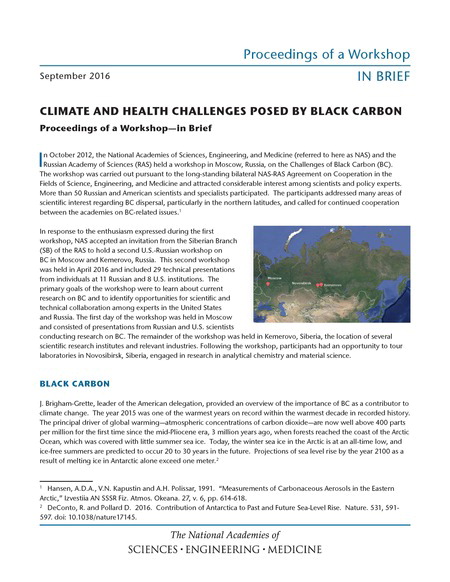 Climate and Health Challenges Posed by Black Carbon: Proceedings of a Workshop–in Brief (2016)
Climate and Health Challenges Posed by Black Carbon: Proceedings of a Workshop–in Brief (2016)
In October 2012, the National Academies of Sciences, Engineering, and Medicine and the Russian Academy of Sciences held a workshop in Moscow, Russia, on the Challenges of Black Carbon (BC). The workshop was carried out pursuant to the long-standing bilateral NAS-RAS Agreement on Cooperation in the Fields of Science, Engineering, and Medicine and attracted considerable interest among scientists and policy experts. More than 50 Russian and American scientists and specialists participated. The participants addressed many areas of scientific interest regarding BC dispersal, particularly in the northern latitudes, and called for continued cooperation between the academies on BC-related issues. A second workshop was held in April 2016 and included 29 technical presentations from individuals at 11 Russian and 8 U.S. institutions. The primary goals of the workshop were to learn about current research on BC and to identify opportunities for scientific and technical collaboration among experts in the United States and Russia. (Development, Security, and Cooperation (DSC))
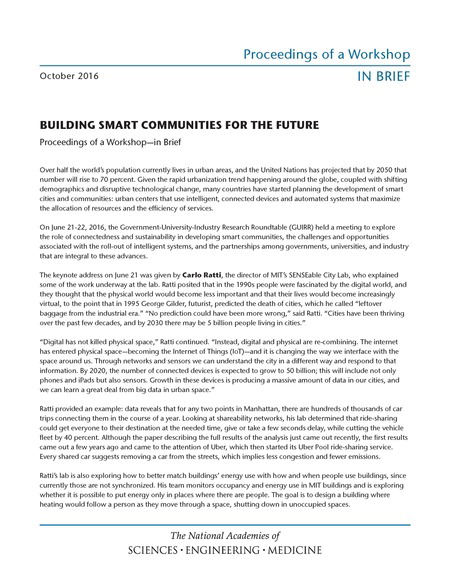 Building Smart Communities for the Future: Proceedings of a Workshop–in Brief (2016)
Building Smart Communities for the Future: Proceedings of a Workshop–in Brief (2016)
Over half the world’s population currently lives in urban areas, and the United Nations has projected that by 2050 that number will rise to 70 percent. Given the rapid urbanization trend happening around the globe, coupled with shifting demographics and disruptive technological change, many countries have started planning the development of smart cities and communities: urban centers that use intelligent, connected devices and automated systems that maximize the allocation of resources and the efficiency of services. (Government-University-Industry Research Roundtable (GUIRR))
 Review of Proposals for Research on Statistical Methodologies for Assessing Variables in Eyewitness Performance (2016)
Review of Proposals for Research on Statistical Methodologies for Assessing Variables in Eyewitness Performance (2016)
Recognizing the importance of eyewitness identifications in courts of law and motivated by data showing that at least one erroneous eyewitness identification was associated with almost 75% of cases where defendants were later exonerated by DNA evidence, in 2013 the Laura and John Arnold Foundation asked the National Academy of Sciences to undertake an assessment of the scientific research on eyewitness identification and offer recommendations to improve eyewitness performance. The appointed committee issued its report, Identifying the Culprit: Assessing Eyewitness Identification, in 2014. (Committee on Science, Technology, and Law)
 The Power of Change: Innovation for Development and Deployment of Increasingly Clean Electric Power Technologies (2016)
The Power of Change: Innovation for Development and Deployment of Increasingly Clean Electric Power Technologies (2016)
Electricity, supplied reliably and affordably, is foundational to the U.S. economy and is utterly indispensable to modern society. However, emissions resulting from many forms of electricity generation create environmental risks that could have significant negative economic, security, and human health consequences. Large-scale installation of cleaner power generation has been generally hampered because greener technologies are more expensive than the technologies that currently produce most of our power. Rather than trade affordability and reliability for low emissions, is there a way to balance all three? (Board on Science, Technology, and Economic Policy (STEP)
 Belarusian-American Workshop on Scientific and Technical Cooperation:
Belarusian-American Workshop on Scientific and Technical Cooperation:
Proceedings of a Workshop in Brief (2016)
The U.S. National Academies of Sciences, Engineering, and Medicine, in cooperation with the National Academy of Sciences of Belarus (NASB), convened an inter-academy workshop on December 15-16, 2015, in Minsk, Belarus. Six American specialists in outreach activities of universities and more than 20 Belarusian scientists, educators, and government officials participated in the workshop. The goals of the workshop were to identify activities of mutual interest to the Academies and to identify technical areas for cooperation. (Development, Security, and Cooperation (DSC))
 Transitioning Toward Sustainability Advancing the Scientific Foundation:
Transitioning Toward Sustainability Advancing the Scientific Foundation:
Proceedings of a Workshop (2016)
In 1999 the National Academies of Sciences, Engineering, and Medicine released a landmark report, Our Common Journey: A Transition toward Sustainability, which attempted to “reinvigorate the essential strategic connections between scientific research, technological development, and societies’ efforts to achieve environmentally sustainable improvements in human well-being.”1 The report emphasized the need for place-based and systems approaches to sustainability, proposed a research strategy for using scientific and technical knowledge to better inform the field, and highlighted a number of priorities for actions that could contribute to a sustainable future. (Science and Technology for Sustainability (STS))
 Optimizing the Nation's Investment in Academic Research:
Optimizing the Nation's Investment in Academic Research:
A New Regulatory Framework for the 21st Century (2016)
Research universities are critical contributors to our national research enterprise. They are the principal source of a world-class labor force and fundamental discoveries that enhance our lives and the lives of others around the world. These institutions help to create an educated citizenry capable of making informed and crucial choices as participants in a democratic society. However many are concerned that the unintended cumulative effect of federal regulations undercuts the productivity of the research enterprise and diminishes the return on the federal investment in research. (Committee on Science, Technology, and Law)
 Quality in the Undergraduate Experience:
Quality in the Undergraduate Experience:
What Is It? How Is It Measured? Who Decides? Summary of a Workshop (2016)
Students, parents, and government agencies need as much information as possible about the outcomes of the higher education experience and the extent to which they can expect a fair return on their investment in higher education. In order to better understand the concept of quality - enabling students to acquire knowledge in a variety of disciplines and deep knowledge in at least one discipline, as well as to develop a range of skills and habits of mind that prepare them for career success, engaged citizenship, intercultural competence, social responsibility, and continued intellectual growth - an ad hoc planning committee of the National Academies of Sciences, Engineering, and Medicine Board on Higher Education and Workforce, with funding from the Lumina Foundation, organized a workshop in Washington, D.C., on December 14-15, 2015.This report summarizes the presentations and discussion of that event. (Board on Higher Education and Workforce)
 Barriers and Opportunities for 2-Year and 4-Year STEM Degrees:
Barriers and Opportunities for 2-Year and 4-Year STEM Degrees:
Systemic Change to Support Students' Diverse Pathways (2016)
Nearly 40 percent of the students entering 2- and 4-year postsecondary institutions indicated their intention to major in science, technology, engineering, and mathematics (STEM) in 2012. But the barriers to students realizing their ambitions are reflected in the fact that about half of those with the intention to earn a STEM bachelor’s degree and more than two-thirds intending to earn a STEM associate’s degree fail to earn these degrees 4 to 6 years after their initial enrollment. Many of those who do obtain a degree take longer than the advertised length of the programs, thus raising the cost of their education. Are the STEM educational pathways any less efficient than for other fields of study? How might the losses be “stemmed” and greater efficiencies realized? These questions and others are at the heart of this study. (Board on Science Education/ Board on Higher Education and Workforce)
 Indo-U.S. Workshop on Challenges of Emerging Infections and Global Health Safety:
Indo-U.S. Workshop on Challenges of Emerging Infections and Global Health Safety:
Summary of a Workshop (2016)
The United States and India have pledged to deepen the linkages between their people, their businesses, and their governments for the mutual benefit of both countries and for the promotion of global peace, stability, economic growth and prosperity. Both nations are now inclined to improve relations and cooperation, but the nations need specific actions that will yield progress and build confidence and momentum for further cooperation. (Committee on International Security and Arms Control (CISAC))
SBIR at NASA (2016)
The Small Business Innovation Research (SBIR) program is one of the largest examples of U.S. public-private partnerships, and was established in 1982 to encourage small businesses to develop new processes and products and to provide quality research in support of the U.S. government’s many missions. The U.S. Congress tasked the National Research Council with undertaking a comprehensive study of how the SBIR program has stimulated technological innovation and used small businesses to meet federal research and development needs, and with recommending further improvements to the program. In the first round of this study, an ad hoc committee prepared a series of reports from 2004 to 2009 on the SBIR program at the five agencies responsible for 96 percent of the program’s operations -- including NASA. In a follow-up to the first round, NASA requested from the Academies an assessment focused on operational questions in order to identify further improvements to the program. (Board on Science, Technology, and Economic Policy (STEP)
 Gain-of-Function Research: Summary of the Second Symposium, March 10-11, 2016 (2016)
Gain-of-Function Research: Summary of the Second Symposium, March 10-11, 2016 (2016)
On March 10-11, 2016, the National Academies of Sciences, Engineering, and Medicine held a public symposium on potential U.S. government policies for the oversight of gain-of- function (GOF) research. This was the Academies’ second meeting held at the request of the U.S. government to provide a mechanism to engage the life sciences community and the broader public and solicit feedback on optimal approaches to ensure effective federal oversight of GOF research as part of a broader U.S. government deliberative process. (Board on Life Science (BLS) /Board on Health Sciences Policy (BHSP) /Committee on Science, Technology and Law(CSTL) )
 Integrating Landscape Approaches and Multi-Resource Analysis into Natural Resource Management: Summary of a Workshop (2016)
Integrating Landscape Approaches and Multi-Resource Analysis into Natural Resource Management: Summary of a Workshop (2016)
The responsible management of natural resources for present-day needs and future generations requires integrated approaches that are place-based, embrace systems thinking, and incorporate the social, economic, and environmental considerations of sustainability. Landscape-scale analysis takes this holistic view by focusing on the spatial scales most appropriate for the resource types and values being managed. Landscape-scale analysis involves assessing landscape features in relation to a group of influencing factors such as land use change, hydrologic changes or other disturbances, topography, and historical vegetation conditions.
 Developing a National STEM Workforce Strategy: A Workshop Summary (March 2016)
Developing a National STEM Workforce Strategy: A Workshop Summary (March 2016)
The future competitiveness of the United States in an increasingly interconnected global economy depends on the nation fostering a workforce with strong capabilities and skills in science, technology, engineering, and mathematics (STEM). STEM knowledge and skills enable both individual opportunity and national competitiveness, and the nation needs to develop ways of ensuring access to high-quality education and training experiences for all students at all levels and for all workers at all career stages. The National Science Foundation (NSF) holds a primary responsibility for overseeing the federal government’s efforts to foster the creation of a STEM-capable workforce. As part of its efforts in this endeavor, NSF funded a workshop that would contribute to its preparation of a theoretical and evidence-based STEM Workforce Development R&D Core Framework. Participants discussed research themes, identified gaps and emerging research opportunities, and recommended refinements in the goals of the framework. This report summarizes the presentations and discussions from the workshop. (Board on Higher Education and Workforce (BHEW)
 Promising Practices for Strengthening the Regional STEM Workforce Development Ecosystem (2016)
Promising Practices for Strengthening the Regional STEM Workforce Development Ecosystem (2016)
U.S. strength in science, technology, engineering, and mathematics (STEM) disciplines has formed the basis of innovations, technologies, and industries that have spurred the nation’s economic growth throughout the last 150 years. Our understanding, however, of how universities receive, interpret, and respond to industry demands for STEM-trained workers is far from complete. This report examines the extent to which universities and employers in five metropolitan communities (Phoenix, Arizona; Cleveland, Ohio; Montgomery, Alabama; Los Angeles, California; and Fargo, North Dakota) collaborate successfully to align curricula, labs, and other undergraduate educational experiences with current and prospective regional STEM workforce needs. Based on examples from these five regions, the report identifies promising practices to create the kind of university-industry collaboration that promotes higher quality college and university course offerings, lab activities, applied learning experiences, work-based learning programs, and other activities that enable students to be successful in the STEM workforce.
 STTR: An Assessment of the Small Business Technology Transfer Program (2016)
STTR: An Assessment of the Small Business Technology Transfer Program (2016)
The Small Business Technology Transfer (STTR) and the Small Business Innovation Research (SBIR) program form one of the largest examples of U.S. public-private partnerships. In the SBIR Reauthorization Act of 2000, Congress tasked the National Research Council with undertaking a comprehensive study of how the SBIR program has stimulated technological innovation and used small businesses to meet federal research and development needs and with recommending further improvements to the program. When reauthorizing the SBIR and STTR programs in 2011, Congress expanded the study mandate to include a review of the STTR program. This report builds on the methodology and outcomes from the previous review of SBIR and assesses the STTR program at the five agencies responsible for 96 percent of the SBIR/STTR operations: DoD, NSF, NIH, NASA, and DoE. (Board on Science, Technology, and Economic Policy (STEP)
 SBIR at the National Science Foundation (2016)
SBIR at the National Science Foundation (2016)
The Small Business Innovation Research (SBIR) program was established in 1982 to encourage small businesses to develop new processes and products and to provide quality research in support of the U.S. government’s many missions. Building on a 2004-2009 assessment, Congress tasked the National Academies with undertaking a second study of how the SBIR program has stimulated technological innovation and used small businesses to meet federal research and development needs, and with recommending improvements to the program. This is one of a series of reports on the SBIR program at the five agencies responsible for 96 percent of the program’s operations -- including the National Science Foundation. Reports on the programs at the Department of Defense and the National Institutes of Health have also been published, as well as a separate report on the Small Business Technology Transfer (STTR) Program. (Board on Science, Technology, and Economic Policy (STEP)
 Immigration Policy and the Search for Skilled Workers: Summary of a Workshop (2015)
Immigration Policy and the Search for Skilled Workers: Summary of a Workshop (2015)
The market for high-skilled workers is becoming increasingly global, as are the markets for knowledge and ideas. While high-skilled immigrants in the United States represent a much smaller proportion of the workforce than they do in countries such as Australia, Canada, and the United Kingdom, these immigrants have an important role in spurring innovation and economic growth in all countries and filling shortages in the domestic labor supply. This report summarizes the proceedings of a fall 2014 workshop that focused on how immigration policy can be used to attract and retain foreign talent. Participants compared policies on encouraging migration and retention of skilled workers, attracting qualified foreign students and retaining them post-graduation, and input by states or provinces in immigration policies to add flexibility in countries with regional employment differences. They also discussed how immigration policies have changed over time in response to undesired labor market outcomes and whether there were sufficient data to measure those outcomes. (Board on Science, Technology, and Economic Policy (STEP)
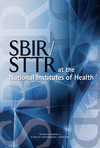 SBIR/STTR at the National Institutes of Health (2015)
SBIR/STTR at the National Institutes of Health (2015)
The Small Business Innovation Research (SBIR) and Small Business Technology Transfer (STTR) programs provide federal research and development funding to small businesses. In 2008, the National Research Council completed a comprehensive assessment of the SBIR and STTR programs. The first-round study found that the programs were "sound in concept and effective in practice." Building on the outcomes from the Phase I study, this second phase examines both topics of general policy interest that emerged during the first phase and topics of specific interest to individual agencies, and provides a second snapshot to measure the program's progress against its legislative goals.
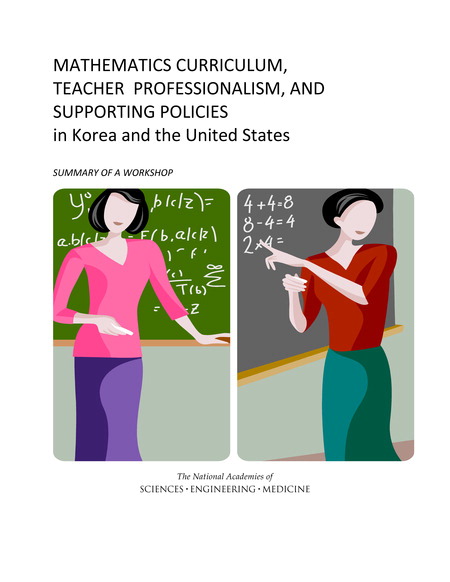 Mathematics Curriculum, Teacher Professionalism, and Supporting Policies in Korea and the United States: Summary of a Workshop (2015)
Mathematics Curriculum, Teacher Professionalism, and Supporting Policies in Korea and the United States: Summary of a Workshop (2015)
On July 15-17, 2012 the United States National Commission on Mathematics Instruction and Seoul National University held a joint Korea-U.S. workshop on Mathematics Teaching and Curriculum. The workshop was organized to address questions and issues related to math teaching and curriculum that were generated by each country, including the following: What are the main concerns in the development of the curriculum? What issues have been discussed or debated among curriculum developers, teachers, teacher educators, and scholars regarding the curriculum? How have textbooks been developed for the curriculum? How are curricular tasks designed and what criteria are used? What is the role of learning trajectories in the development of curriculum? This report summarizes the presentations and discussions at the workshop.
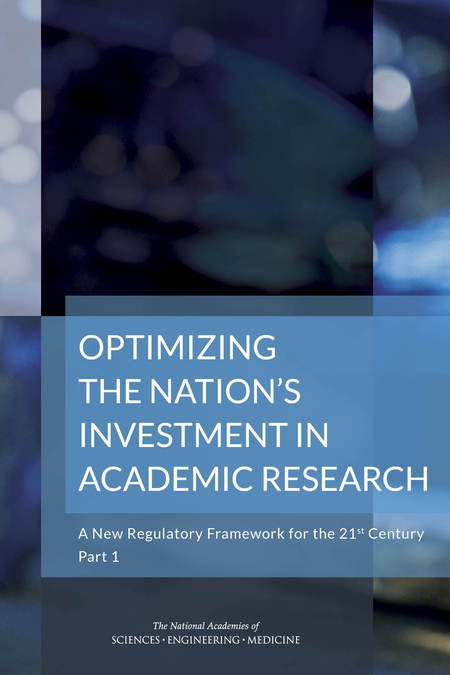 Optimizing the Nation's Investment in Academic Research: A New Regulatory Framework for the 21st Century:
Optimizing the Nation's Investment in Academic Research: A New Regulatory Framework for the 21st Century:
Part 1 (Prepublication release: September 2015)
Research universities are critical contributors to our national research enterprise. They are the principal source of a world-class labor force and fundamental discoveries that enhance our lives and the lives of others around the world. These institutions help to create an educated citizenry capable of making informed and crucial choices as participants in a democratic society. However many are concerned that the unintended cumulative effect of federal regulations undercuts the productivity of the research enterprise and diminishes the return on the federal investment in research. (Committee on Science, Technology, and Law (CSTL)/ Board on Higher Education and Workforce (BHEW))
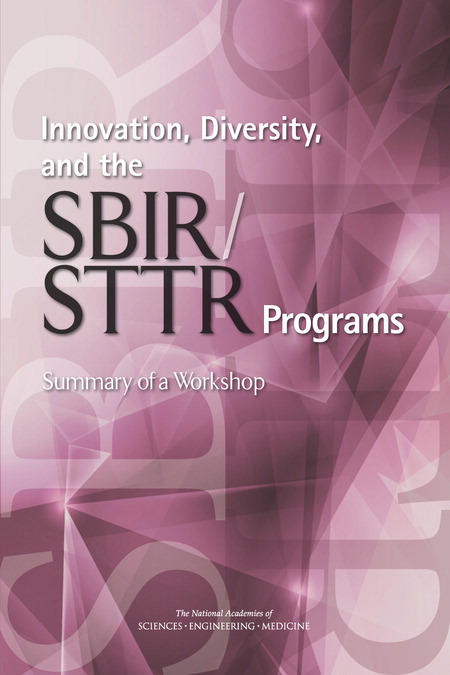 Innovation, Diversity, and the SBIR/STTR Programs: Summary of a Workshop (2015)
Innovation, Diversity, and the SBIR/STTR Programs: Summary of a Workshop (2015)
The Small Business Innovation Research (SBIR) and Small Business Technology Transfer (STTR) programs provide federal research and development funding to small businesses. One of the goals of these programs is to foster and encourage participation by minority and disadvantaged persons in technological innovation. Innovation, Diversity, and Success in the SBIR/STTR Programs is the summary of a workshop convened in February 2013 that focused on the participation of women, minorities, and both older and younger scientists, engineers, and entrepreneurs in the SBIR and STTR programs, with the goal of reviewing current efforts to expand the pool of SBIR/STTR-funded researchers and of identifying mechanisms for improving participation rates. This report is a record of the presentation and discussions of the event. .(Board on Science, Technology, and Economic Policy (STEP))
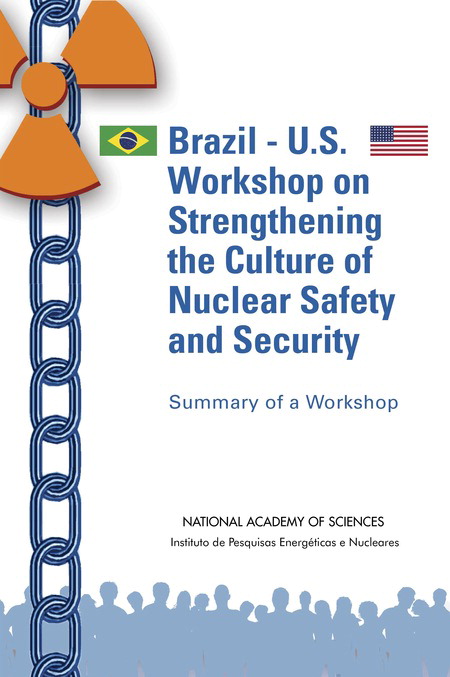 Brazil-U.S. Workshop on Strengthening the Culture of Nuclear Safety and Security: Summary of a Workshop (2015)
Brazil-U.S. Workshop on Strengthening the Culture of Nuclear Safety and Security: Summary of a Workshop (2015)
On August 25-26, 2014, the Instituto de Pesquisas Energ?ticas e Nucleares (IPEN) and the National Research Council of the U.S. National Academy of Sciences convened the Brazil-U.S. Workshop on Strengthening the Culture of Nuclear Safety and Security. The workshop, held on the IPEN Campus in S?o Paulo, Brazil, examined how a culture of nuclear safety and security is built and maintained within the nuclear science, technology, and industrial sectors. Participants identified opportunities for cooperation to strengthen that culture and shared research, perspectives, and practices. This report summarizes the presentation and discussion of that event.
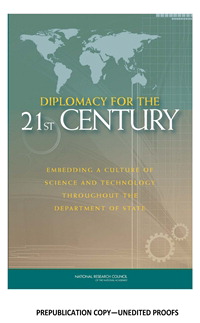
Diplomacy for the 21st Century (2015)
Diplomacy for the 21st Century recommends steps that the Department of State should embrace to take full advantage of the leading science and technology (S&T) capabilities of the United States. These capabilities provide the department with many opportunities to promote a variety of the interests of the United States and its allies in a rapidly changing world wherein S&T are important drivers of economic development at home and abroad and help ensure international security. This report assesses and makes recommendations concerning the changing environment for the conduct of diplomacy in the years ahead, with a focus on the role of S&T in the development and implementation of U.S. policies and programs. According to this report, prompt steps by the department s leadership are essential to ensure adequate comprehension of the importance of S&T-related developments throughout the world and to incorporate this understanding within the nation's foreign policy for the 21st century. This report also urges the adoption by the department of a broader whole-of-society approach in carrying out its responsibilities at home and abroad - extending beyond traditional interagency coordination and the narrow band of current external partners to include foundations, universities, research centers, and other groups who are extending their international reach. (Development, Security, and Cooperation (DSC) )
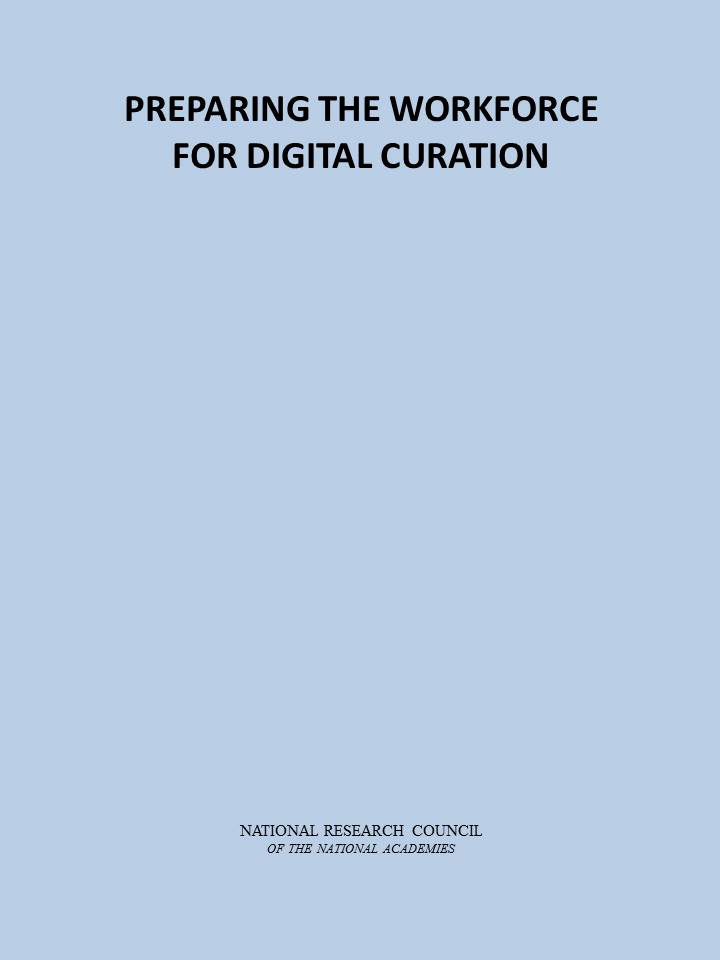 Preparing the Workforce for Digital Curation (April 2015)
Preparing the Workforce for Digital Curation (April 2015)
The massive increase in digital information in the last decade has created new requirements for institutional and technological structures and workforce skills. Preparing the Workforce for Digital Curation focuses on education and training needs to meet the demands for access to and meaningful use of digital information, now and in the future. This study identifies the various practices and spectrum of skill sets that comprise digital curation, looking in particular at human versus automated tasks. Additionally, the report examines the possible career path demands and options for professionals working in digital curation activities, and analyzes the economic benefits and societal importance of digital curation for competitiveness, innovation, and scientific advancement. Preparing the Workforce for Digital Curation considers the evolving roles and models of digital curation functions in research organizations, and their effects on employment opportunities and requirements. The recommendations of this report will help to advance digital curation and meet the demand for a trained workforce. (Board on Research Data and Information)
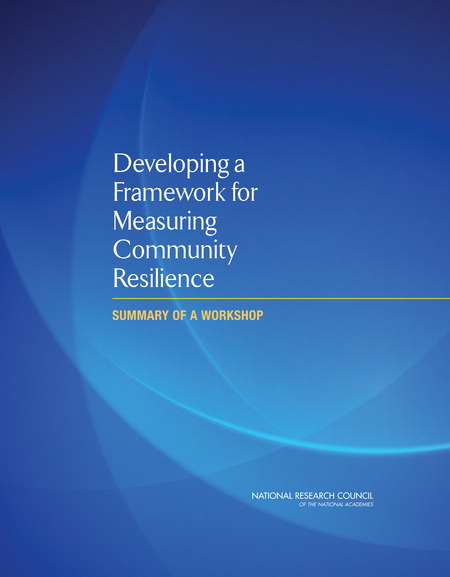 Developing a Framework for Measuring Community Resilience: Summary of a Workshop (March 2015)
Developing a Framework for Measuring Community Resilience: Summary of a Workshop (March 2015)
The 2012 National Research Council report Disaster Resilience: A National Imperative highlighted the challenges of increasing national resilience in the United States. One finding of the report was that "without numerical means of assessing resilience, it would be impossible to identify the priority needs for improvement, to monitor changes, to show that resilience had improved, or to compare the benefits of increasing resilience with the associated costs." Although measuring resilience is a challenge, metrics and indicators to evaluate progress, and the data necessary to establish the metric, are critical for helping communities to clarify and formalize what the concept of resilience means for them, and to support efforts to develop and prioritize resilience investments. One of the recommendations from the 2012 report stated that government entities at federal, state, and local levels and professional organizations should partner to help develop a framework for communities to adapt to their circumstances and begin to track their progress toward increasing resilience. To build upon this recommendation and begin to help communities formulate such a framework, the Resilient America Roundtable of the National Academies convened the workshop Measures of Community Resilience: From Lessons Learned to Lessons Applied on September 5, 2014 in Washington, D.C. The workshop's overarching objective was to begin to develop a framework of measures and indicators that could support community efforts to increase their resilience. The framework will be further developed through feedback and testing in pilot and other partner communities that are working with the Resilient America Roundtable. This report is a summary of the one-day workshop, which consisted of a keynote address and two panel sessions in the morning and afternoon breakout sessions that began the discussion on how to develop a framework of resilience measures. (Resilient America)
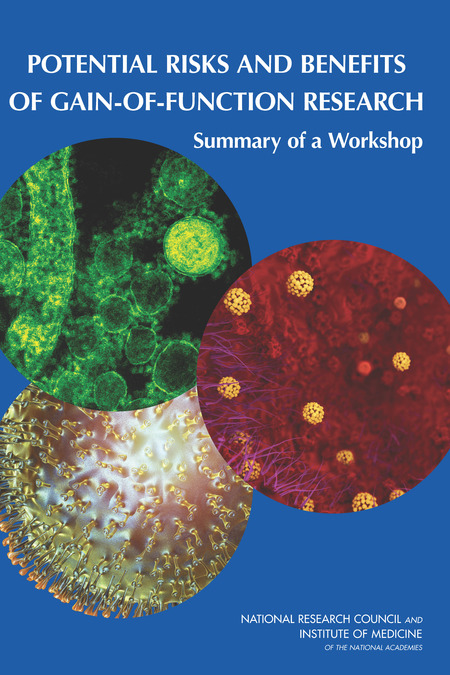 Potential Risks and Benefits of Gain-of-Function Research: Summary of a Workshop (February 2015)
Potential Risks and Benefits of Gain-of-Function Research: Summary of a Workshop (February 2015)
On October 17, 2014, spurred by incidents at U.S. government laboratories that raised serious biosafety concerns, the United States government launched a one-year deliberative process to address the continuing controversy surrounding so-called "gain-of-function" (GOF) research on respiratory pathogens with pandemic potential. The gain of function controversy began in late 2011 with the question of whether to publish the results of two experiments involving H5N1 avian influenza and continued to focus on certain research with highly pathogenic avian influenza over the next three years. The heart of the U.S. process is an evaluation of the potential risks and benefits of certain types of GOF experiments with influenza, SARS, and MERS viruses that would inform the development and adoption of a new U.S. Government policy governing the funding and conduct of GOF research.Potential Risks and Benefits of Gain-of-Function Research is the summary of a two-day public symposia on GOF research. Convened in December 2014 by the Institute of Medicine and the National Research Council, the main focus of this event was to discuss principles important for, and key considerations in, the design of risk and benefit assessments of GOF research. Participants examined the underlying scientific and technical questions that are the source of current discussion and debate over GOF research involving pathogens with pandemic potential. This report is a record of the presentations and discussion of the meeting. (Board on Life Sciences (BLS)/Committee on Science, Technology and Law (CSTL)/Institute of Medicine (IOM))
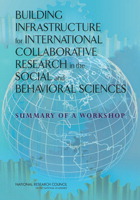 Building Infrastructure for International Collaborative Research in the Social and Behavioral Sciences: Summary of a Workshop (February 2015)
Building Infrastructure for International Collaborative Research in the Social and Behavioral Sciences: Summary of a Workshop (February 2015)
Building Infrastructure for International Collaborative Research in the Social and Behavioral Sciences is the summary of a workshop convened by the National Research Council's Committee on International Collaborations in Social and Behavioral Sciences in September 2013 to identify ways to reduce impediments and to increase access to cross-national research collaborations among a broad range of American scholars in the behavioral and social sciences (and education), especially early career scholars. Over the course of two and a half days, individuals from universities and federal agencies, professional organizations, and other parties with interests in international collaboration in the behavior and social sciences and education made presentations and participated in discussions. They came from diverse fields including cognitive psychology, developmental psychology, comparative education, educational anthropology, sociology, organizational psychology, the health sciences, international development studies, higher education administration, and international exchange. (Board on International Scientific Organizations (BISO))
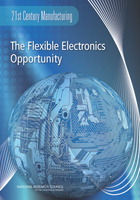 The Flexible Electronics Opportunity (January 2015)
The Flexible Electronics Opportunity (January 2015)
The Flexible Electronics Opportunity examines and compares selected innovation programs both foreign and domestic, and their potential to advance the production of flexible electronics technology in the United States. This report reviews the goals, concept, structure, operation, funding levels, and evaluation of foreign programs similar to major U.S. programs, e.g., innovation awards, S&T parks, and consortia. The report describes the transition of flexible electronics research into products and to makes recommendations to improve and to develop U.S. programs. Through an examination of the role of research consortia around the world to advance flexible electronics technology, the report makes recommendations for steps that the U.S. might consider to develop a robust industry in the United States.Significant U.S. expansion in the market for flexible electronics technologies is not likely to occur in the absence of mechanisms to address investment risks, the sharing of intellectual property, and the diverse technology requirements associated with developing and manufacturing flexible electronics technologies. The Flexible Electronics Opportunity makes recommendations for collaboration among industry, universities, and government to achieve the critical levels of investment and the acceleration of new technology development that are needed to catalyze a vibrant flexible electronics industry.(Board on Science, Technology, and Economic Policy (STEP))
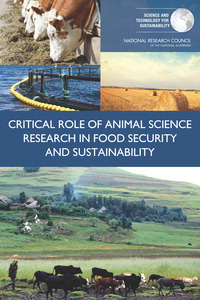 Critical Role of Animal Science Research in Food Security and Sustainability (2015)
Critical Role of Animal Science Research in Food Security and Sustainability (2015)
This report identifies areas of research and development, technology, and resource needs for research in the field of animal agriculture, both nationally and internationally. This report assesses the global demand for products of animal origin in 2050 within the framework of ensuring global food security; evaluates how climate change and natural resource constraints may impact the ability to meet future global demand for animal products in sustainable production systems; and identifies factors that may impact the ability of the United States to meet demand for animal products, including the need for trained human capital, product safety and quality, and effective communication and adoption of new knowledge, information, and technologies. (Science and Technology for Sustainability (STS))

















